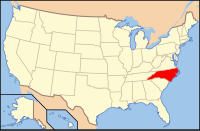Burke County, NC
| Burke County, North Carolina | ||
|---|---|---|

Burke County Courthouse
|
||
|
||
 Location in the U.S. state of North Carolina |
||
 North Carolina's location in the U.S. |
||
| Founded | 1777 | |
| Named for | Thomas Burke | |
| Seat | Morganton | |
| Largest city | Morganton | |
| Area | ||
| • Total | 515 sq mi (1,334 km2) | |
| • Land | 507 sq mi (1,313 km2) | |
| • Water | 8.0 sq mi (21 km2), 1.5% | |
| Population | ||
| • (2010) | 90,912 | |
| • Density | 179/sq mi (69/km²) | |
| Congressional district | 11th | |
| Time zone | Eastern: UTC-5/-4 | |
| Website | www |
|
Burke County is a county located in the U.S. state of North Carolina. As of 2010 census, the population was 90,912. Its county seat is Morganton.
Burke County is part of the Hickory–Lenoir–Morganton, NC Metropolitan Statistical Area.
The first European settlement in the interior of North Carolina (and what would become the United States) was made by a Spanish expedition in 1567, when they built Fort San Juan at the large Mississippian culture Native American chiefdom of Joara. Present-day Morganton later developed at this site. The Spanish renamed the settlement Cuenca. The following year the Indians killed nearly all the Spanish garrisoned at this and five other interior forts, and burned Fort San Juan. It was two centuries before Europeans tried to settle again this far west in the colony.
Indigenous peoples inhabited the interior as well as the coastal areas for thousands of years. Native Americans of the Mississippian culture inhabited the county long before Europeans arrived in the New World. The largest Mound Builder settlement was at Joara, a 12-acre (49,000 m2) site and regional chiefdom near present-day Morganton. It was the center of the largest Native American settlement in North Carolina, dating from about 1000 AD and expanding into the next centuries.
In 1567, a Spanish expedition arrived and built Fort San Juan, claiming the area for the colony of Spanish Florida. They had been sent by the governor at Santa Elena (Parris Island) in South Carolina. Captain Juan Pardo, leader of the expedition, left about 30 soldiers at the fort while continuing his exploration. In the spring of 1568 the Indians attacked the fort, killing the soldiers and burning the fort. Indians killed the garrisons at five other Spanish forts in the interior. Introduction of European diseases caused high fatalities among the Mississippians, and takeover of survivors by larger tribes led to Native American abandonment of the area. Two hundred years passed before the next Europeans: English, Scots-Irish and German colonists, attempted to settle here again.
...
Wikipedia

